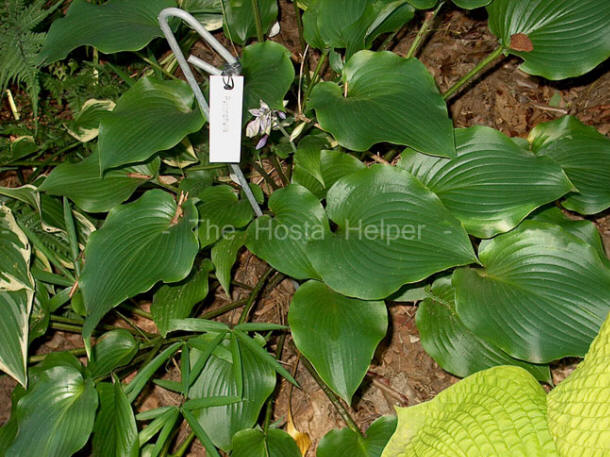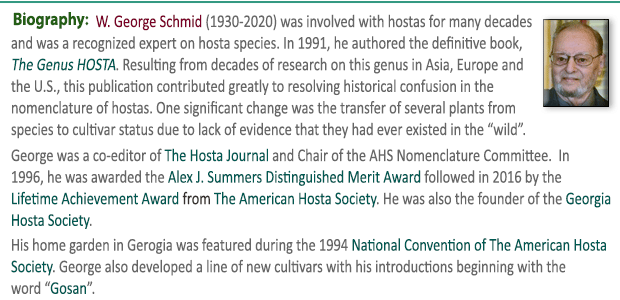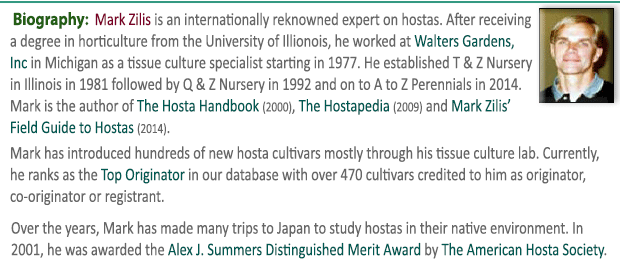|
 This medium size (19 inches
high by 60 inches wide) species of hostas from
Japan has an intense white bloom on the bottom of the
pie crust shaped leaves. The striped
flowers are medium lavender and appear from mid-August into September
followed by viable seeds. This medium size (19 inches
high by 60 inches wide) species of hostas from
Japan has an intense white bloom on the bottom of the
pie crust shaped leaves. The striped
flowers are medium lavender and appear from mid-August into September
followed by viable seeds.

According to
The Hostapedia by Mark Zilis (2009), "Since H. pycnophylla is
native to only a few Japanese islands, it is remarkable that it
has become such an important breeding plant...Traits that H. pycnophylla seedlings exhibit include recumbent scapes,
white floral bracts, an intensely white bloom on the leaf
underside, and good marginal rippling."
In the
The Genus Hosta by W. George Schmid (1991), it states that this species was
discovered on mountain ridges. The epithet means "densely arranged leaves".
 The New Encyclopedia of Hostas by
Diana
Grenfell (2009) states: "A superb parent for white-backed, ripple-edged
hostas and now the pod parent of a superb, thick, yellow-leaved hybrid, H. 'Aliyah's
Grace'. Wild specimens are much smaller than those in cultivation, although it
is not an easy hosta to grow, seeming to dwindle rather than increase." The New Encyclopedia of Hostas by
Diana
Grenfell (2009) states: "A superb parent for white-backed, ripple-edged
hostas and now the pod parent of a superb, thick, yellow-leaved hybrid, H. 'Aliyah's
Grace'. Wild specimens are much smaller than those in cultivation, although it
is not an easy hosta to grow, seeming to dwindle rather than increase."
Mark Zilis' Field Guide to Hostas (2014)
states that this species was found in Japan in "...woodlands..."

An article by W. George Schmid in
The
Hosta Journal (2002 Vol. 33 No. 2) states that, "Among
the most remarkable species is H. pycnophylla.
Bob Olson would call it
"a white-backed-leaf little devil-to-grow plant." Despite how
difficult it is to grow, it has become a favored source of
genetic material because its leaves have a very chalky white
back. It is rare in the wild and not east to find or get to.
...1)
In the South, H. pycnophylla needs mostly morning sun in spring and shade in
summer...in the North, it needs more sun than shade all day in both spring and
summer. This species is very shy about flowering if it does not get enough
sun...2) As with all relatives of H. longipes, the plant does best if you supply
plenty of water...particularly during summer drought periods. 3) In the North,
plant this species in an open location facing south or southeast to gain
additional growing season...since this is a southern, long-growing-season
species that requires plenty of moisture and warmth (even heat) to flower and
set seed."
An article by Warren I. Pollock in
The
Hosta Journal (2003 Vol. 34 No. 1) states that, "H. pycnophylla, the pollen parent of 'Cutting Edge', was named by
Dr. Fumio Maekawa
in 1976...The green leaves which can be as large as 8 inches long by 7 inches
wide at maturity, have slightly rippled margins and white undersides -- from
which 'Cutting Edge' gets its principal handsome attributes.
The
Hosta Journal, (2006 Vol. 37 No. 2), in an article
about flower characteristics stated that this species has "...nearly horizontal scapes with the full weight of the
blooms..."
 An article by Warren I. Pollock in
The
Hosta Journal (2014 Vol. 45 No. 2) states that, "H. 'Liberty Bell' crossed with ('Urajiro Hachijo' ×
H. pycnophylla) is a favorite
pod parent of Don's (Don Dean). He used it to produce H. 'Celtic Bouquet' and H.
'Peek-a-boo Purple', both registered in 2011, and H. 'Ebony Towers' and H.
'Garnet Spires', in 2005. (Special Note: Parentages of 'Garnet Spires' and
'Peek-a-boo Purple' were corrected in the 2013 Registrations issue..." An article by Warren I. Pollock in
The
Hosta Journal (2014 Vol. 45 No. 2) states that, "H. 'Liberty Bell' crossed with ('Urajiro Hachijo' ×
H. pycnophylla) is a favorite
pod parent of Don's (Don Dean). He used it to produce H. 'Celtic Bouquet' and H.
'Peek-a-boo Purple', both registered in 2011, and H. 'Ebony Towers' and H.
'Garnet Spires', in 2005. (Special Note: Parentages of 'Garnet Spires' and
'Peek-a-boo Purple' were corrected in the 2013 Registrations issue..."
Mikiko Lockwood in an article on The Hosta Library titled,
A Little About Japanese Hosta Terms defines the term urajiro as white-backed or white underside.









|



